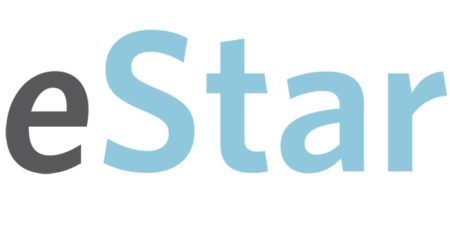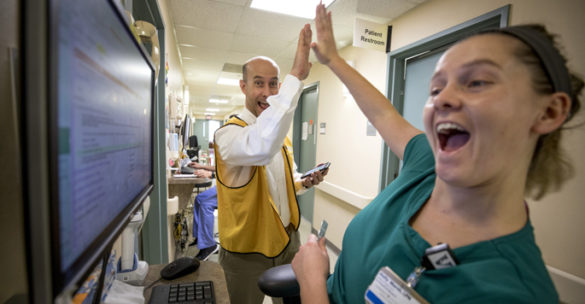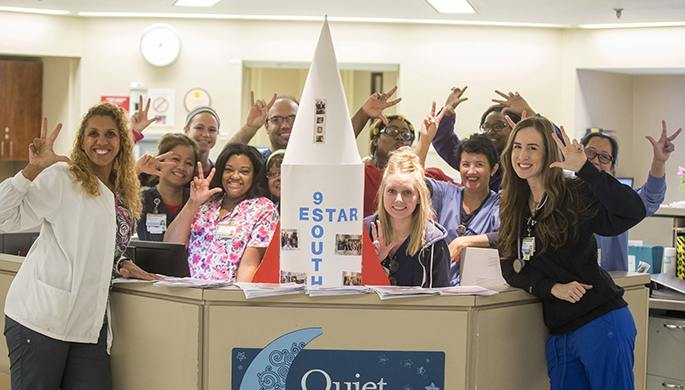Recently, thousands of Vanderbilt University Medical Center (VUMC) employees took a moment to stop by Langford Auditorium so members of leadership could thank them for their time, effort and dedication in making the historic transition to VUMC’s new Epic-based electronic health record system, known as eStar. They viewed photos and videos from Go Live, read personal thank-you messages from EpicLeap team leadership, received a special gift and were able to reflect on all their hard work in making the eStar implementation a success.
Although last November’s Go Live is now officially part of the Medical Center’s history, extensive work continues as groups all over VUMC focus on stabilizing eStar. To help lead this Stabilization phase, a new group has been established.
Led by Paul Sternberg Jr., MD, Chief Medical Officer, and Marilyn Dubree, MSN, RN, Executive Chief Nursing Officer, the eStar Stabilization Oversight Group builds on the successful collaboration among Vanderbilt’s clinical, operational and technology leadership teams from the Go Live phase. This collaboration resulted in rapid decision-making, effective prioritization and extensive accountability from across the institution. As VUMC neared the end of its Go Live period, there remained a number of complex issues that required continued mobilization and ongoing oversight.
These post-Go Live challenges have been organized into a number of workgroups, each of which has been assigned owners from VUMC’s clinical and operational teams. Each workgroup will receive extensive support from the HealthIT department. This shared ownership model continues that collaboration VUMC experienced during Go Live.
Currently, the eStar Stabilization Oversight Group has 11 workgroups in progress (the three workgroups listed first are its highest priorities:
1 — Clinical work queue management
2 — Patient communications (InBaskets)
3 — Clinician and staff support
4 — Document and scanning management
5 — Clinic check-in/intake
6 — Internal communications
7 — Hospital and professional billing revenue reconciliation and stabilization
8 — External communications (referring physicians and document faxing)
9 — Discharge management (hospital)
10 — Clinical effectiveness goals
11 — Denials reduction
For example, the Clinician and Staff Support workgroup is responsible for building on the successful at-the-elbow support model of Go Live, which included staff super users, clinician champions and nurse preceptors. This team will determine the optimal way to ensure Medical Center colleagues can continue to ask questions and get prompt assistance from their own team members, as they did during the Go Live period.
Another workgroup addressing clinic check-out is on hold until March 1.
The efforts of the Oversight Group mirror many of the recommendations that Epic made following its first post-Go Live site visit. The visit, which took place in late January, comprised colleague surveys and interactions with many areas in Vanderbilt’s hospitals and clinics. Epic used survey data and observations from its visit to provide a list of areas on which the software vendor suggested VUMC focus during the Stabilization phase.
“Seeing Epic’s recommendations confirmed that our Oversight Group has the right list of priorities in front of us,” Sternberg said. “A consistent theme in their report was that we optimize our use of InBaskets in eStar. We’ve been working on InBaskets since Go Live, as this will be a big step in improving efficiency and the overall patient experience. However, we also recognize that there are a number of other critical areas still needing attention and are committed to accelerating our rate of movement toward stabilization.”
The site visit also validated the Oversight Group’s emphasis on directing additional resources to Vanderbilt’s outpatient clinics.
“We believe that, overall, our hospitals weathered the transition to eStar better than our clinics did,” Dubree said. “Epic’s data and report clarified that we definitely need to continue to direct our immediate efforts toward our clinics, as that is where we have the most stabilization work to do.”
In addition to Sternberg and Dubree, membership of the eStar Stabilization Oversight Group includes:
- Madison Agee (HealthIT)
- Gayla Harvey (Finance)
- Jim Hollender (Children’s Hospital)
- Shubhada Jagasia, MD (Department of Medicine)
- Chris Lee (Pediatric Clinics)
- Scott McCarver (Adult Hospital)
- Brent Moseng (HealthIT
- Neal Patel, MD, MPH (HealthIT)
- Kristy Sinkfield (Strategy and Innovation)
- Janice Smith (Adult Clinics)
The group will continue in this oversight function as long as VUMC remains in this particular phase of an Epic implementation project — a phase that can last several months in an academic medical center of Vanderbilt’s size.















